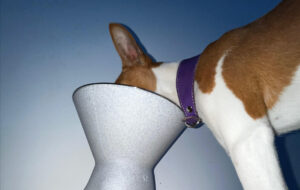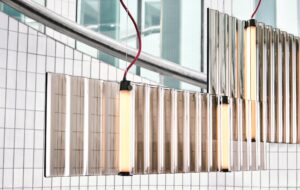
Words William Wiles
The new building of the Ecole cantonale d’art de Lausanne (ECAL) has been built around the frame of a place that made hessian sacks and has kept its industrial feel – huge open spaces, bare walls, concrete floors, exposed services.
It’s a look that suits the school. While its European competitors, such as the Royal College of Art and the Design Academy Eindhoven, experiment with abstraction and flirt with art, ECAL adheres faithfully to the modernist idea of design – that it is the overture to manufacturing, not a conceptual end in itself. It is almost stereotypically Swiss: pragmatic, practical, efficient and rich.
Through ECAL’s sprawling new home races the figure of Pierre Keller, its director. Attempting to keep up with him is a dazed and dwindling entourage of designers, academics and journalists, many of whom have become lost on the way. Huge vistas of the new building open up suddenly – vast teaching spaces, serried ranks of empty desks, broad, bare corridors and atria – and then disappear as the tour moves on. Eventually we reach the enormous corner office from where Keller will rule his empire. He turns to face the remains of the party and exclaims, puzzled: “Everyone has disappeared!”

Keller must often wonder why the rest of the world is dawdling behind him. He’s 62, diminutive and stout, but nevertheless an incredibly imposing figure. The force of his personality, and the energy and charisma behind it, puts him immediately at the centre of any room he enters. He seems capable of exhausting and bewildering men half his age. “He’s a superb director,” says the Parisian designer Florence Doléac, who teaches at the school. “He knows every student, he controls everything, every single detail. You could say it’s excessive or crazy, but at the end because of this kind of personality he has, this sensibility, he succeeded in transforming this very small, little school. Nobody knew about it ten years ago.”
Now, however, ECAL is on the map. Its European and global reputation is enormous considering the fact that it has only 412 students, less than half the number at the RCA, and it attracts the likes of Ronan Bouroullec, Yves Béhar – both alumni – Fernando Campana and Richard Hutten to teach on its design courses. ECAL’s new building, in the Lausanne suburb of Renens, cements Keller’s achievements of 12 years as director. Designed by Bernard Tschumi, it unites the school’s formerly scattered facilities onto a single site and includes large exhibition spaces for the Espace lausannois d’art contemporain (ELAC), of which Keller is also a director, and a new home for the local polytechnic. There are also small studios for hire to local businesses.


But despite these multiple functions, the building impresses with its vast expanses of space. Tschumi’s design is not an expression of what ECAL does already but the embodiment of Keller’s vaulting ambitions for the school. “If I had not said that we needed a new school, there would be no new school,” Keller says. “I decided to convince the political people that the school was so good, we needed somewhere better to work. When a company says, ‘Everything’s OK, it’s perfect,’ it means it’s already going down. You absolutely need to be better every day.”
“ECAL is not a democracy,” says Bouroullec, who has taught at the school for six years. “It’s a dictatorship.” Keller runs the place as an absolutist, with a micro-managing flair and a happy disregard for bureaucracy and administrative process. It’s an intensely personal style of management – Keller uses his own signature as the school’s semi-official logo, adorning menus, itineraries and T-shirts – yet it makes ECAL an appealing place to teach for designers such as Bouroullec. They relish the lack of bureaucracy and freedom to teach as they wish, backed by the financial resources of the Swiss state, which knows the value of design and invests heavily in education. “Keller has a particular sense of what he can get from whom, what kind of energy, where you are most effective,” says Doléac.

That force of personality can be formidable to the point of intimidating. Thanks to a mix-up and a missed flight, I arrived in Lausanne a few hours later than expected. When I met Keller he was charm personified, but nevertheless he grabbed my ear and gave it a hard twist – he doesn’t like things not going to plan. On his right side he’s an inspiration, but students and staff alike say that he is a not a man to cross. “I always say that we never take ourselves seriously, but we do everything seriously,” Keller says.

What makes his control possible is his knack for spotting talent and making appointments in which he can trust absolutely. A good example is Alexis Georgacopoulos, who was put in charge of ECAL’s department of industrial design in 2000 at the tender age of 24, and is now jointly credited with Keller for much of the school’s recent design success. Georgacopoulos feels that one of its secrets is the ability to cut through institutional red tape. “What Pierre Keller has been able to do – we are able to decide very quickly if we do something or not, how we do it, and that speeds up the process incredibly,” says Georgacopoulos. This means, for instance, considerable co-operation between the courses taught at ECAL. Alongside industrial design, the school teaches visual communication, graphic design, photography, media and interactive design, film studies and fine arts. Exhibitions or products put together by the industrial design department are supported by the other courses – the work is shot by photography students and the advertising assembled by graphics students. All of which means students across the board are exposed early to the processes of entering products into a media-driven marketplace.

This ultra hands-on approach looks set to increase in the new building: previously, the school’s administration and teaching areas were divided across two sites – now they are together, so Keller’s influence will never be very far away. “Before, in the old building, we were insulated from the energy of Pierre Keller – when he came in, it was always a big deal,” says Augustin Scott de Martinville, member of Belgium-based design collective Big-Game and an ECAL graduate who teaches there. “Now he’ll be here all the time.”
This ethos trickles down to the students. “I never saw anywhere else on this planet more motivated students than the ones in Lausanne,” says Dutch designer Richard Hutten. And this enthusiasm and motivation manifests itself not in flights of fancy, but in a restless, practical and pragmatic work ethic on the part of the student body. Their work is typified by professionalism, an atmosphere now reflected in the new premises. It’s not the quirky, collegial environment of the RCA. The teaching areas in the new building are businesslike, and on a corporate rather than individualist scale. A key factor in this ethos is ECAL’s close links with industry. The new building was greatly aided by a generous – and uncharacteristic – donation from Ikea towards an auditorium. Established brands are intimately involved in the school’s work – recent collaborations encompassed global corporations such as Coca Cola, manufacturers including B&B Italia, Vitra, Boffi and Eternit, and European luxury goods firms such as Swarovski, Christofle, Bernardaud and Louis Vuitton. These partnerships result in work like Delphine Frey’s porcelain ice cream cone for Bernardaud: witty, practical and in production. Another example is Michel Charlot’s Mold Lamp, developed with Eternit – a lampshade (now followed by a stool) that plays with industrial materials in an innovative way to create a manufacturing-friendly design.

“We work a lot with industry, but in a real way,” says Georgacopoulos. Whereas a lot of schools simply take briefs or materials from manufacturers, ECAL’s ventures over the past five or six years have been collaborative from beginning to end, often ending with objects going into production. “As a second-year student, when they are not yet graduated, it’s incredible to have a project that is already on the market,” Georgacopoulos adds.
Again and again, ECAL’s staff refer back to these collaborations as being the school’s big advantage over its peers. “It’s very good for students, because they can understand what is the relationship to their partner, and they get the possibility to make nice prototypes, and develop their designs,” says Doléac. “I think when you have a partner you understand the system of production, the politics of the industry, the role of the workers, your responsibilities when you design something and when someone uses his hand to build it.”

Like the new building, these ties are entirely the result of Keller’s networking efforts, and his personal control over the collaborations. “Usually schools work with companies just for research, nothing else, but I take care myself of the project and I follow these things to the end,” Keller says. This direct involvement means that the close working relationship with manufacturers does not result in businesses calling the shots over the school’s curriculum. Firms get the use of ECAL’s pool of creative talent to refresh their lines, but don’t get to decide the school’s policy. Only Keller decides that.

















